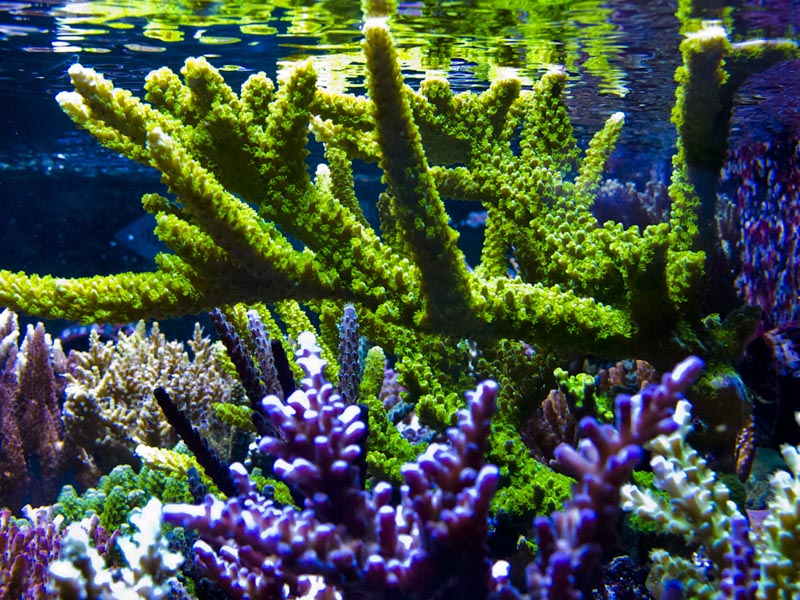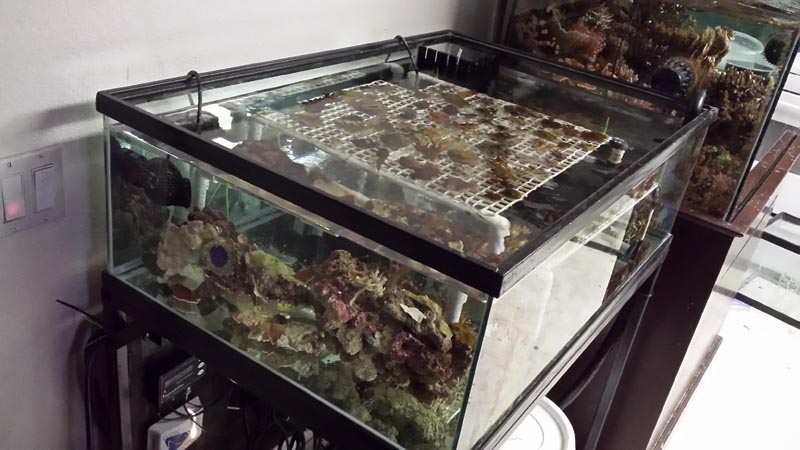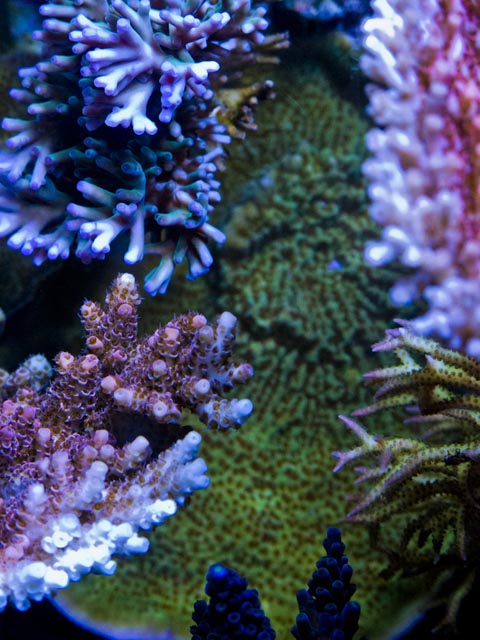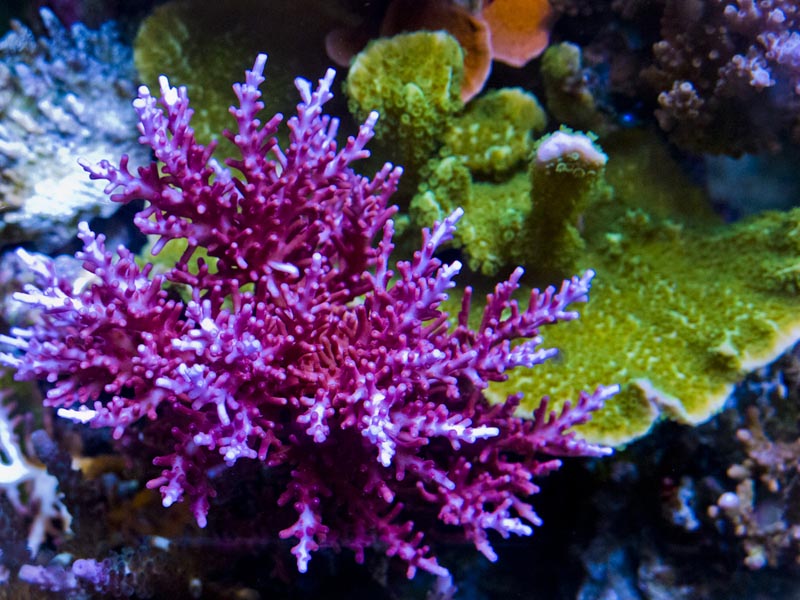 October 2013 Tank of the Month
October 2013 Tank of the Month
October 2013 Tank of the Month
Brahm Goodis' (MammothReefer) 67 US-gallon Rimless Reef Aquarium
 |
Introduction
I am ecstatic about being nominated for Tank of the Month. I never thought that my tank would be worthy of the title and I’m grateful to have the opportunity to share it with this community. I can’t thank the forum readers and staff enough. I have always looked to previous Tank of the Months for inspiration and it’s a huge honor to be amongst that list.
 |
Background
I first got into reef keeping when an old roommate gave me a 20-gallon tank and all the equipment I needed to get started on the cheap… or so I thought at the time. Dozens of tanks, thousands of gallons, an online business or two, and 11 years later, little did I know what started off as a free tank and a couple clown fish would have developed into a lifelong passion. While the hobby can be challenging at times, those challenges help to keep things interesting. Seeing your hard work come to fruition is really rewarding. It is a privilege to take care of these animals from all over the world and watch them thrive in my living room. There is a certain relaxing aspect of a reef aquarium that provides a nice contrast to the hectic work day, like coming home to the familiar blue glow, the gentle swaying of corals, and being able to sit back and watch. However, the best part of reef keeping has always been the community. I have met many great friends over the years and without the support and camaraderie amongst our fellow reefers, my tank never would have progressed past those first 20-gallons.
Current System
My current system is a 67-gallon SPS specific reef aquarium. Built off a Solana 34-gallon aquarium that I picked up off a fellow RC member, this tank was a return to the hobby after taking a 3-year hiatus. When planning the system, I had a goal of trying to stick to a species-specific tank. Taking what I had learned from my last system (a 500-gallon mixed reef), I really wanted to condense it down and focus on what interested me most: acropora and acanthastrea. Due to the shallow depth of the tank and demanding requirements of the acropora, I found myself forced to make a choice and decided to dedicate the tank entirely to SPS. With that in mind, much of my fish and coral selection were selected to complement this decision. I’ve always been a fan of overcrowded SPS tanks and my plan was to try to capture the essence of some of the tanks that have inspired me in the past. The system consists of a 67-gallon Starphire rimless display tank with hidden internal bracing and a 45-gallon frag tank that share a common sump via a standard 40-gallon breeder. The system is maintained by an acJR that controls the heaters, lights, dosing pumps, fans, and ATO. Four Vortechs on reef crest mode handle water motion. I’m using an Eheim 1262 to pass water to both the frag and display tanks, which then return to the sump via filter socks that are replaced twice a week. Water quality is maintained with an oversized SRO XP-2000 skimmer and GFO/Carbon via BRS dual-chamber reactor, as well as water changes performed bi-weekly using IO and RODI water. Lighting is provided from two 250 watt radium SE bulbs in Luminarc mini reflectors. All my essential equipment are split between multiple GFCI units. If one of the GFCI units trip the tank in theory should continue to safely run until I am able to resolve the issue and reset the GFCI. One of the key things to me that makes my tank stand out is that almost all of my equipment has been acquired through my fellow RC members. Thanks to the community, I’ve been able to put this together without breaking the bank.
 |
System Profile
• Display tank: 67 Gallon Rimless Display tank with internal bracing 36”x24”x18” on a metal stand with a removable facade
• Frag Tank: 45 Gallon Frag tank 36”x24”x12” on a homemade metal stand
• Sump: 40 Gallon Breeder
• Skimmer: SRO XP-2000 Cone
• Biofilter: Liverock
• Carbon & Phosphate Filtration: BRS carbon and HC GFO in BRS dual reactor
• Return Pump: Eheim 1262
• Water Circulation: Vortech MP40 x2, Vortech MP10 x2, Modded Tunze 6025 x2
• Lighting: 250W 20K Radim metal halide in Luminarc Minis and a Bluewave ballast x2
• Calcium / Alk / Magnesium Dosing: BRS dry product on BRS dosing pumps
• Auto Top-Off: JBJ A.T.O. Water Level Controller
• RO/DI: Air Water Ice Typhoon III
• Heating & Cooling: 300W Ebo Jager heater x2 / Fans blowing over the top of the tank x2
• System Controller: Neptune Systems AquaController Jr
• Salt: Instant Ocean
Inhabitants
Much like my equipment, the vast majority of my inhabitants come from fellow RC members, friends, and local coral growers in the Southern California area. While I tend to gravitate towards captive-raised, I am not one to shy away from wild or maricultured corals. Some of my favorite corals have come in as hitchhikers, browned out specials, or have shifted from what I thought they would be into something very different. My green polyp blue tort started as nothing more than a brown unknown coral, whereas my Red Stag was initially purchased as a millepora but instead took on some kind of Stag formation to my surprise. Others started out as teeny specks, like my Red Dragon, pink lemonaide, and unknown species orange and green coral. My focus on this tank has always been coral-specific. It is not that I am not a “fish guy” but given the limited size of this tank it was about the corals this time around. I’ve tried to limited my fish to useful species. A Starry Blenny and a yellow Tang help with algae control. The Melanurus Wrasse initially helped with pest control, but when the corals became too dense, he started slacking on the job. What would be a tank without a pair of clownfish? So, I added a pair of captive-raised black and white Misbarred Ocellaris that spawn regularly. An oversized Starcki Damsel and a Sunrise Dottyback add a little color to the tank as well. The original plan was to have the tank populated by a plethora of nano-sized fish, such as mini Gobies and Blennies, the necessity of the Wrasse for pest control didn’t allow for that to happen and the open top rimless tank presented jumping concerns. In the future, I’d like to return to my original stocking plan. Unfortunately, I do not have much in the way of inverts at this time, but I do see a pair of skunks, and some anemone shrimps or crabs in the future.
 |
Feeding
Given the limited number of fish, feeding is kept at a minimum. I typically feed pellets with nori to the fish and supplement the corals with Oyster feasters and reef-roids. When available I will feed frozen foods such as Mysis, brine, Cyclops, and Rods Reef. Living in a small mountain town limits how often I have access to frozen food.
|
Water Parameters:
|
Philosophy & Challenges
One of the main things I took away from experiences gained from past tanks was that long-term success with SPS could be attributed to stability, simplicity, and redundancy where needed. When designing this tank, I kept those things in mind, from how I planned and conducted my maintenance routines, made stocking decisions, selected equipment, all the way down to how I wired everything together. All parameters and activities are tracked via an online spreadsheet. I have used calcium reactors, manual 2 part, and kalkwasser to maintain my levels in the past. With this system, I leaned towards automated three part dosing. I dose once an hour over a 24-hour period. In the future I plan to change my dosing to accommodate for daily variations by doing the bulk of my dosing while the lights are on. For me dosing has always been a simple and effective method to maintaining constancy of magnesium, calcium, and alkalinity. When adjusting my levels, typically, I dose to maintain a specific alkalinity range and then adjust needed magnesium and calcium to match. As a fan of Carbon dosing, I started out the tank on BioPellets, but eventually removed them to switch around how I plumbed the sump, as well as use a different reactor. While I never got Biopellets back online, I never intended to remove them permanently. As the tank matured, I found myself becoming reluctant to change anything, always finding “one more” thing I needed to dial in before I was ready to add any complexities to the system. With Carbon dosing offline I found, I could achieve similar results by limiting the number of fish as well as the species diversity within the tank. Running passive carbon and GFO, keeping a tight water change schedule, and regular filter sock replacements kept things humming along. It is a bit “Old School” but it does the trick. When it comes to maintaining specific water parameters, I’ve found it’s easiest to shoot for middle of the road numbers. While they may not result in optimal growth or coloration, given the variances between different test kits, I have always felt the safest giving myself the largest buffer possible on either end of the spectrum. Like any system, I faced my fair share of challenges some of which I am still dealing with to this very day. Most of my pest related issues could have avoided with simple precautions such as a proper QT system or more aggressive action as soon as the issue was identified, others resolved themselves, while others were treated with a simple in tank treatment. New challenges appeared as the tank matured and my total water volume became too small, I added on the frag tank in an effort to add more volume to the system for that very reason. While my tank has managed to thrive with AEFW for the majority of its life, it has not been an easy battle. Weekly basting with a maxijet, and turkey baster combined with dipping of species that I know can withstand the treatment has allowed me to keep moving forward but has left me unable to participate in one of the most cherished parts of the hobby, trading and interacting with my fellow Reef Keepers. Moving forward, I do plan to QT and dip all corals in an effort to finally rid the tank of any pests. The biggest challenge for me has always been deciding when to take action and when to take a hands-off approach. We as hobbyists can often be our own worst enemies more. What made the biggest difference between this system and some of the others I had kept in the past was learning not to overreact. When it came to maintaining my water chemistries stability I started to use a methodology of averages assuming any one test could be an anomaly I only made changes to my system when multiple tests over the course of a set period of days, or weeks showed a pattern of change.
 |
Acknowledgment
I’d like to thank Reef Central, and the members of RC for the honor of being TOTM, my friends and family for their support and sacrificial hardwood floors, my significant others (past and present) for their patience while I pondered endlessly over corals at every LFS I could drag you to, Dave & Jess (Treylene), Charles (ChinMonster), Lance (torquester), and Victoria (Victoria) for all the help, advice, heavy lifting, and of course all of our great coral runs/adventures, all the folks from the Southern California Reefers forum for the great swaps and frags, as well as members of the SPS Keepers forum for all their support and inspiration. – Brahm (MammothReefer)
 |
Feel free to comment or ask questions about my tank in the Tank of the Month thread on Reef Central.



